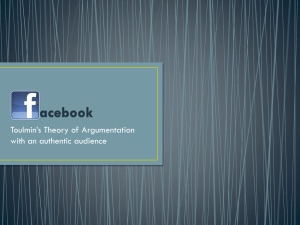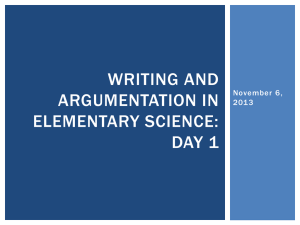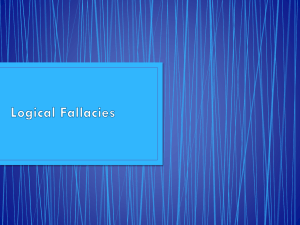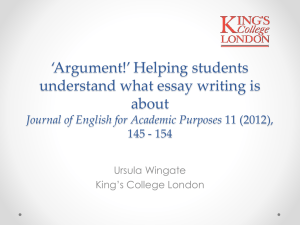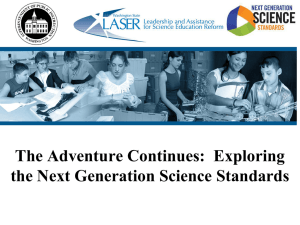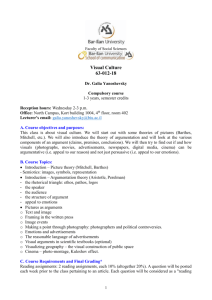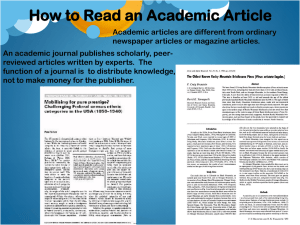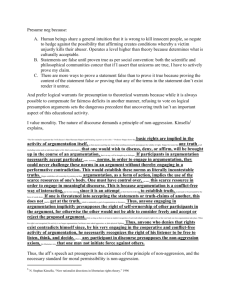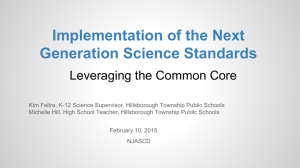PowerPoint
advertisement
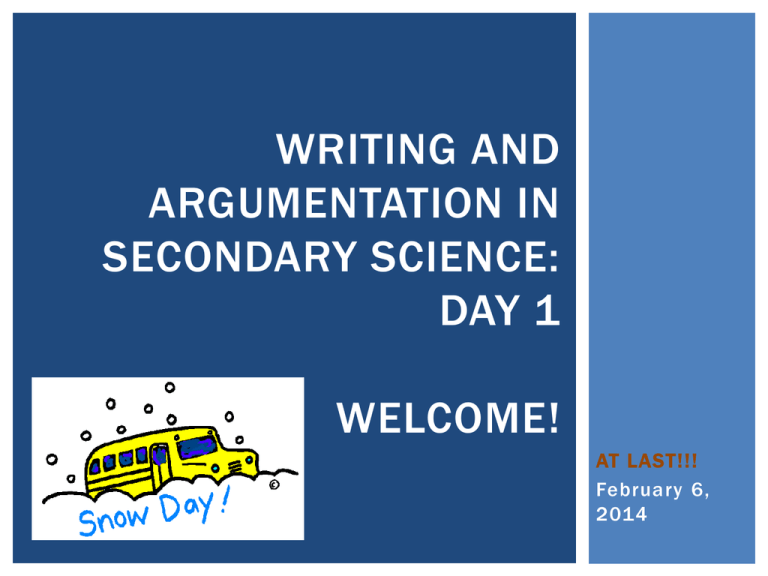
WRITING AND ARGUMENTATION IN SECONDARY SCIENCE: DAY 1 WELCOME! AT LAST!!! February 6, 2014 “LITERACY IS THE LITMUS PAPER OF THOUGHT…THE VERY CENTER OF SCHOOLING.” ~TED SIZER In the context of teaching science, what does this quote mean to you? WHAT DOES ARGUMENT MEAN IN OUR EVERYDAY LANGUAGE? ARGUMENT CLINIC ARGUMENT IN SCIENCE In science, an argument is used… “to promote as much understanding of a situation as possible and to persuade colleagues of the validity of a specific idea….[it] is ideally about sharing, processing, and learning about ideas” (NRC 2008, p 89) EXPLORING ARGUMENT IN THE CLASSROOM Title, Author Definition of Scientific Argument What does argument look like in the classroom? (General Structure) Specific classroom example Best quote from the article Recommendation: Read this article! It’s awesome because… (or opposite) A NEW MODEL FOR THE PRACTICE OF SCIENCE ORCHESTRA STUDENTS ARE MUSICIANS; STUDENTS ON THE BASKETBALL TEAM ARE ATHLETES; WHAT OPPORTUNITIES DO OUR SCIENCE STUDENTS HAVE TO BE SCIENTISTS? WHY IS ARGUMENT IMPORTANT IN THE SCIENCE CLASSROOM? Write Around BREAK NEXT GENERATION SCIENCE STANDARDS NEXT GENERATION SCIENCE STANDARDS (NGSS) ARCHITECTURE OF THE NGSS: PERFORMANCE EXPECTATIONS Performance Expectations: •These describe what a student should be able to do at the end of a unit •They are not meant to be lesson sequences or required activities ARCHITECTURE OF THE NGSS Disciplinary Core Ideas Science and Engineering Practices Crosscutting Concepts ARCHITECTURE OF THE NGSS: CONNECTIONS Connections to: •Other content/gradebands within the NGSS •Common Core State Standards for ELA/Literacy and Mathematics NGSS RESOURCES http://www.nextg enscience.org/nex t-generationscience-standards OUR SHIFT IN THINKING… From thinking that one scientific method fits all To t h i n king a bo ut h ow to e n g a ge o ur s t ude n t s i n t h e pra c t i c e s o f s c i en tists 1. Asking questions and defining problems 2. Developing and using models 3. Planning and carrying out investigations 4. Analyzing and interpreting data 5. Using mathematics and computational thinking 6. Constructing explanations and designing solutions 7. Engaging in argument from evidence 8. Obtaining, evaluating and communicating information OUR SHIFT IN THINKING… From thinking that “handson” science is ESSENTIAL To thinking that engaging students EVERY DAY in scientific practices and thinking is POWERFUL A NEW MODEL FOR THE PRACTICE OF SCIENCE SHIFTING OUR PRACTICE… Next Generation Science Standards Science & Engineering Practices 1. Asking questions and defining problems 2. Developing and using models 3. Planning and carrying out investigations 4. Analyzing and interpreting data 5. Using mathematics and computational thinking 6. Constructing explanations and designing solutions 7. Engaging in argument from evidence 8. Obtaining, evaluating and communicating information From… How am I going to teach this? To… How are students going to learn about this? WRITING AND ARGUMENTATION Next Generation Science Standards Science & Engineering Practices 1. Asking questions and defining problems 2. Developing and using models 3. Planning and carrying out investigations 4. Analyzing and interpreting data 5. Using mathematics and computational thinking 6. Constructing explanations and designing solutions 7. Engaging in argument from evidence 8. Obtaining, evaluating and communicating information Which Science and Engineering Practices (SEP) best support writing and argumentation? WRITING AND ARGUMENTATION According to the SEP, what are the hallmarks of a high quality argument at your grade level? GETTING STARTED Claim – Evidence – Reasoning (CER) CLAIM: What do you know? EVIDENCE: How do you know that? REASONING: Why does your evidence support your claim? CLAIM – EVIDENCE – REASONING (CER) What grade level? Rewrite the student response so it reflects a higher grade band. How might the task be changed to produce a higher level of student work? SO HOW DO WE PUT IT ALL TOGETHER SO THAT IT’S MEANINGFUL FOR OUR STUDENTS? When procedures are uniform for all students, where data are similar, and where claims match expected outcomes, then the reportage of results and conclusions often seems meaningless to students and lacks opportunities for deeper student learning about the topic or for developing scientific reasoning skills. (If everyone gets the same answer why ask the question? How meaningful is this type of experience? Is this just another school exercise done to them ?) ~Hand, Norton-Meier, Staker, and Bintz When procedures are uniform for all students, where data are similar, and where claims match expected outcomes, then the reportage of results and conclusions often seems meaningless to students and lacks opportunities for deeper student learning about the topic or for developing scientific reasoning skills. (If everyone gets the same answer why ask the question? How meaningful is this type of experience? Is this just another school exercise done to them ?) ~Hand, Norton-Meier, Staker, and Bintz We need to change our thinking with respect to experimentation! EXPERIMENTATION Conventional Separate Unit on the Scientific Method Then spend the rest of the year learning content through text resources or telling. EXPERIMENTATION Conventional ? Students read the text to learn vocabulary and background information about clouds. Students then observe the cloud in a jar that confirms what they already “know.” EXPERIMENTATION Shifts in Practice for NGSS ? Students ask questions about cloud formation and do some investigating on their own. Students search for answers to their questions as they read the text. 5E LEARNING CYCLE 5E Model is based from the SCIS Model of Instruction by researchers Atkins and Karplus in 1967. 5E Model was originally proposed by BSCS (Biological Science Curriculum Study) in the late1980’s. 5E LEARNING CYCLE Engage Explore Explain Elaborate Evaluate http://www.bscs.org/bscs-5e-instructional-model HOW DOES ARGUMENT FIT INTO THE 5E LEARNING CYCLE? Engage Explore Explain Elaborate Evaluate http://www.bscs.org/bscs-5e-instructional-model ENGAGE Draw a diagram that shows how both people can see the light. What ideas or questions do you have about how light travels? EXPLORE What can you find out about the way light travels? What if you have 2 light sources? EXPLORE How is this the same? Different? What image will you see? EXPLORE What can you find out now? EXPLORE How is this the same? Different? What will you see on the screen? EXPLAIN Activity Observations How do these observations help answer the focus question? Imagine that you have a pair of Magic Science Glasses. When you look at light with your Magic Science Glasses, you see the particles that make up light. How does light travel? Light particles… …travel in straight lines …travel in all directions …are invisibly small …travel at high speed Put on your Magic Glasses and “look” at the light particles that we’ve been experimenting with. Use what you see about how these particles are behaving and what they look like to explain all the patterns we noticed in our experiments. Use a whiteboard to create a representation that answers the focus question: How does light travel? EXPLAIN Activity Observations How do these observations help answer the focus question? DEVELOPING A SCIENTIFIC ARGUMENT Engage Explore Explain LUNCH TASKS FOR ARGUMENTATION JEREMY’S VACATION Using the data provided, create a representation that will help you show which city Jeremy should visit and at what time of year (spring, fall, winter, or summer). You may represent your data in any way you choose. You may choose to represent all or only some of the data, as long as you can use your representation to justify your recommendations for Jeremy’s vacation (where to go and when to go there). From Cartier, Smith, Stein, and Ross, 5 Practices for Orchestrating Productive Task-Based Discussions in Science, NSTA Press, 2013, page 3. COMPARING 2 TASKS Task A Create a bar graph that shows the average monthly high and low temperatures in each city. Identify where and when Jeremy should go on vacation. Task B Using the data provided, create a representation that will help you show which city Jeremy should visit and at what time of year (spring, fall, winter, or summer). From Cartier, Smith, Stein, and Ross, 5 Practices for Orchestrating Productive Task-Based Discussions in Science, NSTA Press, 2013, page 3. TASKS THAT SUPPORT ARGUMENTATION High cognitive demand Students engage in multiple ways that are productive Students produce artifacts Student artifacts Task Science concept T YPES OF TASKS Experimentation Tasks Data Representation, Analysis, and Interpretation Tasks Explanation Tasks From Cartier, Smith, Stein, and Ross, 5 Practices for Orchestrating Productive Task-Based Discussions in Science, NSTA Press, 2013, page 3. FEATURES OF LOW AND HIGH COGNITIVE DEMAND TASKS What do you notice? What do you wonder? From Cartier, Smith, Stein, and Ross, 5 Practices for Orchestrating Productive Task-Based Discussions in Science, NSTA Press, 2013, page 3. LOW OR HIGH COGNITIVE DEMAND? How might you increase the cognitive demand of From Cartier, Smith, Stein, and Ross, 5 Practices for Orchestrating Productive this task? Task-Based Discussions in Science, NSTA Press, 2013, page 3. BEFORE WE MEET AGAIN… Develop a learning cycles or task that provides opportunities for argumentation. Use the Low/High Cognitive Demand Chart to guide your work Bring examples of student work (written work, photos of whiteboards, etc…) to our next meeting on March 13!
